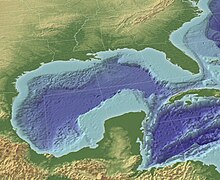The Gulf of Mexico is an ocean basin or bay of the Atlantic Ocean. It is a marginal sea of North America. The United States of America, Mexico, and Cuba are the countries around it.

The Straits of Florida connect to the rest of the Atlantic Ocean, and the Yucatán Channel connects to the Caribbean Sea. Because of its narrow connection to the Atlantic Ocean, the Gulf has very small tides.
The size of the Gulf basin is about 1.6 million km2 (615,000 sq mi). Almost half of the basin is shallow continental shelf waters. The climate is tropical, with heavy growth of plankton and sea grass.

Petroleum is found near the north and west coast of this gulf. Many hurricanes hit this area, for example, Hurricane Katrina and Hurricane Rita hurt many of the oil wells in 2005 in the United States. There is also a big fishing industry in the gulf. The Gulf of Mexico is one of the most important offshore petroleum production regions in the world, making one-sixth of the United States' total production.[1]
The Gulf was formed by plate tectonics about 300 million years ago.[2]
2025 change in the gulf name
changeThe whole surface area of the gulf is 1,550,000 km2 (600,000 sq mi).[3] United States jurisdiction in the gulf extends to waters 3 to 200 nm (5 to 322 km) off the coast.[4] The area in which the United States has jurisdiction is called exclusive economic zone (EEZ). Also on the bottom of the water basin is the continental shelf of the United States. Maritime nations have sovereign rights over their continental shelves. United States total EEZ surface area in the gulf is 695,565 km2 (268,515 sq mi)[5] and the country's total continental shelf area in the same body of water is 644,960 km2 (249,000 sq mi; 159.36 million acres)[6]. Both in its' exclusive economic zone and its' continental shelf area the United States of America has control over fishing, mining, oil exploration, and other economic and resource management.[7] The external boundary of the US exclusive economic zone and the external boundary of the US continental shelf area overlap in the basin at 200 nm from the coastline.[8]
On 9 June 2000, the United States of America and Mexico signed the "Treaty on the Delimitation of the Continental Shelf in the Western Gulf of Mexico Beyond 200 Nautical Miles"[9], thus establishing the continental shelf boundary between them in the western part of the gulf that is beyond 200 nautical miles. The instruments of ratification of the treaty were exchanged on 17 January 2001 and it entered into force the same day[10]. A similar contract, "The Treaty on the Delimitation of the Continental Shelf in the Eastern Gulf of Mexico Beyond 200 Nautical Miles", was signed on 17 January 2017 between the US and Cuba, but is yet to be ratified.[11]
From 2025 onwards the United States continental shelf area in the gulf and therefore the water above that area, that constitutes the country's exclusive economic zone, will be called "The Gulf of America", as per an executive order signed by the 47th President of the United States of America Donald Trump. The change in the name affects the way United States federal institutions will refer to the gulf in their official maps, documents, communications and etc.[12] The executive order was signed on 20 January 2025 and on 24 January 2025 the United States Department of the Interior and the United States Board on Geographic Names started its' implementation.[13]
As soon as the new name is updated in the Geographic Names Information System, users of Google Maps will start to see the change. Users in the United States will see only the name "Gulf of America", while everyone else around the globe will see both names of the gulf.[14]
The other two basin countries - Cuba and Mexico, alongside the rest of the world, have the authority to select what name they would prefer to use regarding the United States section of the gulf.[15]
References
change- ↑ "Gulf of Mexico Fact Sheet". U.S. Energy Information Administration. Archived from the original on December 18, 2020. Retrieved March 26, 2018.
- ↑ Huerta A.D. & Harry D.L. 2012. Wilson cycles, tectonic inheritance, and rifting of the North American Gulf of Mexico continental margin. Geosphere. 8(1):GES00725.1, March 6, 2012. doi:10.1130/GES00725.1
- ↑ "A Long-term View of the Gulf of Mexico". www.ncei.noaa.gov. 2020-10-27. Retrieved 2025-01-31.
- ↑ "Marine Jurisdictions". www.ncei.noaa.gov. Retrieved 2025-01-30.
- ↑ "Catches by Taxon in the waters of USA (Gulf of Mexico)". www.seaaroundus.org. Retrieved 2025-01-31.
- ↑ "Outer Continental Shelf". www.boem.gov. Retrieved 2025-02-01.
- ↑ "Convention on the Continental Shelf 1958" (PDF). www.legal.un.org. Retrieved 2025-02-01.
- ↑ "Maritime Zones and Boundaries". www.noaa.gov. 2024-12-13. Retrieved 2025-01-31.
- ↑ "Treaty Between the UNITED STATES OF AMERICA and MEXICO" (PDF). www.state.gov. Retrieved 2025-02-02.
- ↑ "Mexico (01-117) – Treaty on the Delimitation of the Continental Shelf in the Western Gulf of Mexico Beyond 200 Nautical Miles". www.state.gov. 2001-01-17. Retrieved 2025-02-02.
- ↑ "THE TREATIES WITH THE REPUBLIC OF CUBA AND THE GOVERNMENT OF THE UNITED MEXICAN STATES ON THE DELIMITATION OF MARITIME BOUNDARIES" (PDF). www.congress.gov. Retrieved 2025-02-02.
- ↑ "RESTORING NAMES THAT HONOR AMERICAN GREATNESS". www.whitehouse.gov. 2025-01-20. Retrieved 2025-01-30.
- ↑ "Interior Department Advances Restoration of Historic Names Honoring American Greatness". www.doi.gov. 2025-01-24. Retrieved 2025-01-30.
- ↑ "Google Maps will change the Gulf of Mexico to the Gulf of America". www.edition.cnn.com. 2025-01-28. Retrieved 2025-01-30.
- ↑ "Trump renames Gulf of Mexico to Gulf of America. But is it really that easy?". www.eu.usatoday.com. 2025-01-21. Retrieved 2025-01-30.